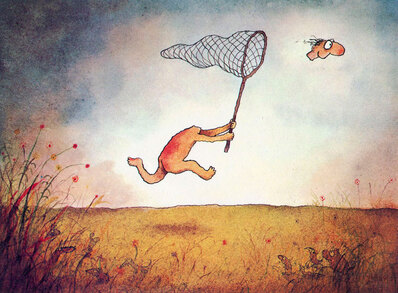|
Thinking is a primitive form of action which, like any kind of action, has consequences. Occasional thoughts can repeat to become habitual. Habitual thoughts shape mental traits and, in so doing, subtly shape character. This happens quietly, gradually, moment by moment, day by day, via the innumerable judgements of the ever-active, thinking mind.  Image courtesy of Michael Leunig Image courtesy of Michael Leunig Becoming aware of this process exposes the sheer saturation of thought in one’s life. It reveals the emotional substrate to our thinking, which normally goes unnoticed. It also shows us how the mushroom clouds of proliferating thought affect how we feel and how we act. Formal mindfulness practices, which encompass a range of meditative techniques, share a common thrust of taming the restless human mind in kindly, patient ways so that we might act in ways that make us feel good. Fundamental to this endeavour is working skilfully with thought and how it relates to our wider experience. We begin to see how emotions build up through thought, expressing themselves via ideas and impacting on our physicality and behaviour. Mindfulness practice is about letting go of potent tendencies to indulge thoughts and to create a fixed identity out of them. It leads to a disenchantment with all the arbitrary content that rolls through the mind. Paradoxically, this grants a greater flexibility and creativity for one’s life. True Reflections One escape route from webs of proliferating thought is through conscious reflection on thoughts themselves. When you are experiencing painful or uncomfortable feelings, such as anxiety or anger, deliberately stop what you are doing and take a look at the thought-stream running through your mind. If necessary, write down the thoughts you spot. Find out everything you can about what is bothering you. Then give your full attention to the following questions:
From: Mindfulness for Unravelling Anxiety (2016). Comments are closed.
|
Posts
June 2024
ArchivesRead archive posts on Blogspot Categories |
 RSS Feed
RSS Feed